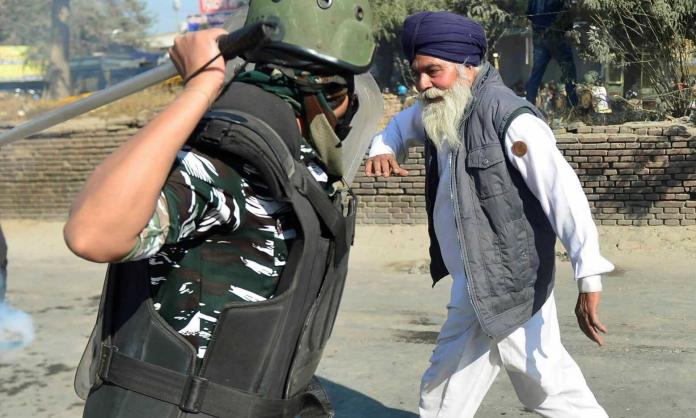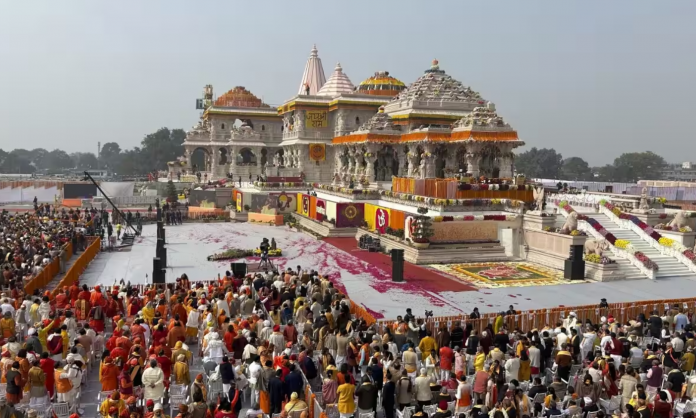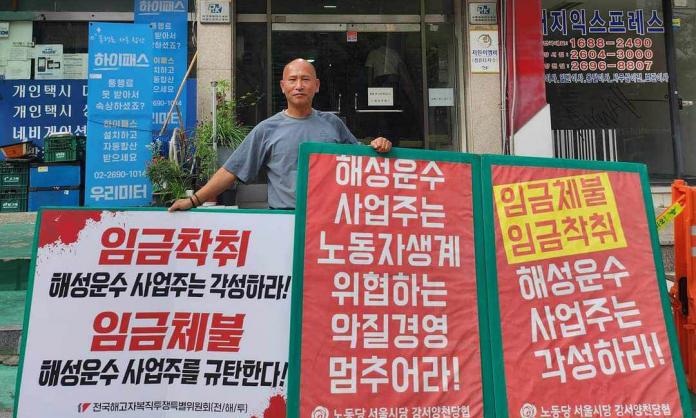India is witnessing one of the largest farmers’ protests in decades. More than 200,000 are camped out in trucks and trailers along all the highways leading into the national capital, New Delhi. As the farmer convoys were making their way, police blocked their route in several places with boulders, concrete road dividers, shipping containers and trenches. They attacked protesters with batons, tear gas and water cannons. The determined farmers pushed through regardless, shunting aside any barricades and overwhelming the police with sheer numbers. They were finally stopped just outside the city limits by special armed forces.
This is no one-day demonstration. The convoys began in late November, and the encampment has now lasted seven weeks, creating transport bottlenecks in one of the most important industrial and commercial regions of the country. With makeshift kitchens, electricity generators and supplies to last months, the farmers make a credible threat that they will continue this semi-blockade of the capital until their demands are met. Eight rounds of talks with the government have failed to convince them to compromise.
With increasing support from local community organisations, and with the continual inflow of reinforcements of farmers and solidarity contingents from non-farmer activist campaigns, the protesters’ political confidence is high. They have declared that if their demands are still unmet by 26 January, marking two months since the start of the convoys and coinciding with a national holiday that commemorates the Indian constitution, they will march into Delhi.
The farmers demand the repeal of a set of farm acts rammed through parliament in late September by the far-right BJP (Bharatiya Janata Party, or Indian People’s Party), which rules at the federal level. On 12 January, the Supreme Court provisionally suspended the farm laws and appointed a committee to look into the farmers’ grievances. As a result, there are calls for the farmers to disband their blockade. However, the farmers point out that the committee appointees are well known for their support for the farm laws. They see the Supreme Court action as a demobilising tactic ahead of the 26 January ultimatum, and they are determined to continue their protest.
To appreciate the grievances of farmers, it is worth beginning with their situation before these acts were passed. Agriculture employs almost half of the workforce of India. According to the 2011 census (the latest available), more than half of this agricultural workforce is landless: tenant farmers or wage labourers. Of farmers who do own land, 86 percent are small (owning less than two hectares) or marginal (less than one hectare). They usually work with just ox and plough, and hand-dug irrigation canals.
For the past three decades, small farmers have faced a dire economic situation as they struggle to match the low sales prices of the big farmers who own the most fertile land and can afford high productivity inputs like tractors, mechanised irrigation, fertilisers and pesticides. There are tens of thousands of farmer suicides annually as small farmers despair at the prospect of forfeiting their land when they find themselves unable to repay usurious loans they have taken to pay for inputs at the start of each sowing season.
As dire as this situation was, it was prevented from being even worse by various kinds of government support. State-run agricultural produce markets and granaries maintain minimum prices for many agricultural products. These give farmers a level of certainty about the sale price for their produce when they make sowing decisions. While such measures disproportionately benefit big farmers, some benefits flow through to the rest. This regime of state regulation is to be dismantled by the new farm acts.
Writing in the Indian journal Economic & Political Weekly, Pritam Singh argues that the main objective of the farm acts is to open state-regulated agriculture to big agribusiness, both foreign and domestic. In the process, the acts will economically weaken small and medium farming households to the point that they cannot make a livelihood as farmers any more. Many will be compelled to sell their farms and become wage labourers, whether remaining in the rural economy or migrating to the cities. Both rural and urban wages will likely be pushed down as a result.
However, the tensions are not simply between agribusiness and farmers. A second dynamic involves a tussle between the federal government and various states, the latest incarnation of a long-running tension between centralism and regionalism in Indian politics. This is an important element in explaining why opposition to the farm acts has spread beyond farmers’ organisations to many mainstream parties. Agricultural policy has largely been a matter for states, not for the federal government. The acts take a major step in centralising not only the policy, but also control over the tax revenue from the local agricultural produce markets that states currently control.
Patronage is a big part of Indian politics: the doling out of spoils of office to cronies through subsidies and contracts. It would be a big blow to regional parties if they have less to dole out. While only the ruling BJP and the opposition Congress Party can claim a national presence and hope to anchor ruling coalitions nationally, there are more than a dozen regional parties with a solid voter base in their region. They are perennial contenders as the ruling party at the state legislature level. The BJP too was once a regional party like them, but is aggressively trying to consolidate its national position by pushing out any regional rivals where it can.
The main organising vehicle behind the protests, the All India Farmers’ Struggle Coordination Committee (AIKSCC), is an umbrella body that covers hundreds of farmer unions and civil society groups. It represents various political forces—conservatives, liberals and leftists. Noting this diversity is important in assessing how the farmer protests might impact broader social currents, given that the past two years have been a time of mass politicisation, hundreds of thousands of newly engaged protesters looking for a political lead.
The BKU (Bharatiya Kisan Union, or Indian Farmers Union) and the SSS (Swabhimani Shetkari Sanghtana, or Farmer Pride Organisation) are two prominent organisations under the umbrella. They have bases among farmers in the states of the north and west of India respectively. While their mobilising rhetoric is about farmers as a unified identity, their practice reflects class stratification among farmers. Their leaders orient to big farmers. Yet they frequently mobilise masses for demonstrations, including large numbers of marginal and small farmers.
On the one hand, these farmer organisations have a history of agitating for government- subsidised inputs and guaranteed minimum prices for outputs, and against the effects of globalisation and the entry of agribusiness into Indian agriculture. On the other hand, they oppose higher wages for farm labour, and they oppose land redistribution to landless tenant farmers or farm labourers. In the past, the SSS has joined state ruling coalitions with the BJP and other far-right parties in the state of Maharashtra. The BKU’s social basis is tied up with conservative clan/caste institutions called khap panchayats at the village level that maintain, in part, the subjugation of women and of Dalits (an outcaste population who are mostly landless agricultural labourers).
Among the civil society organisations under the AIKSCC umbrella is the National Alliance of People’s Movements, whose roots trace back to protest campaigns in the 1980s and 1990s against the effects on the poor of industrial development and market liberalisation. One of its leaders, Medha Patkar, has a decades-long international reputation for her human rights activism, especially in relation to protesting the displacement of tribal and village communities by the construction of big dams in the west and centre of India.
Another influential organisation in the AIKSCC is Swaraj Abhiyan (Campaign for self-rule), which grew out of a populist anti-corruption movement in the early 2010s in the north that generally positioned itself as “neither left nor right”. One of its two main leaders, Yogendra Yadav, is a political scientist known for his writings on trends in electoral politics in India, such as the increasing sway of regional parties as opposed to parties that have a national profile. Its other main leader, Prashant Bhushan, is a public interest lawyer, son of another famous lawyer-activist and former law minister. This gives some indication of the party’s progressive urban middle-class image and appeal.
The AIKSCC also includes left peasant organisations of the communist tradition. Their base is generally among marginal and small farmers (and they usually have separate unions of agricultural labourers). These parties have trade union wings that helped organise the large nationwide one-day general strikes that have occurred at least once a year over the last few years against the BJP’s labour policies. The trade unions claim to have involved 200 million in the general strike of 27 November last year, which was timed to coincide with the start of the farmers’ march convoy. The demands of the general strike included the repeal of the farm acts and the repeal of the spate of anti-labour laws that the unions had already been protesting since June.
Given their politics and economic program, the most that the farmer unions or civil society groups can do is to delay the liquidation of the small farmers. Ultimately, their liquidation is caused not by this or that law, but by capitalist pressures from big farmers that drive less competitive farmers into bankruptcy. By contrast, the left organisations at least have an agenda of land reform and anti-capitalism.
To assess the impact of the farmer agitation, we must look beyond the single issue of the farm acts and consider their effects on a society that was already in turmoil. Since late 2019, the BJP had been on a rampage, abrogating the limited democracy that existed in Indian-occupied Kashmir, passing anti-Muslim laws, enacting severe attacks on labour rights and pushing various ideological crusades to embolden its Hindu fundamentalist base. This provoked the largest counter-protests in decades. The BJP retaliated by arresting prominent activists and intellectuals. It unleashed deadly violence on protesters and on Muslim neighbourhoods—deploying both police and RSS goons (the RSS is a non-parliamentary fascist outfit that is the parent organisation of the BJP). Many political parties caught between the far-right rampage and the protesters in the streets found themselves forced to make public statements against the BJP.
Given this context, such a large mobilisation of farmers is a particularly welcome development. Farmers are well organised in India, more so than either Muslims or the far left. They are an important voting base for major parties that may back them—at least opportunistically, even if in another context they might be happy to side with agribusiness against farmers. The farmer protests also amplify anti-BJP sentiment among the Indian middle classes, where the BJP has its main voter base. Thus far, the BJP has not felt confident enough to start arresting leaders of the farmer protests, or to send its goons to beat up farmers, as it did with anti-government protesters last year. It may be that the popularity of the farmer agitation widens the space for dissent and protest, which had previously been shrinking.
Some parties outside the AIKSCC umbrella did not initially build the farmer protests but declared support once the protests showed themselves to be large and popular. For them, the issue is above all their electoral prospects in the north, a key part of the country where the BJP over the last few years has been trying to take over, but where these regional parties have managed to make a foothold for themselves.
The Shiromani Akali Dal (Supreme Akali Party), a major electoral force in Punjab and currently in opposition, is a centre-right party based on Sikh identity and Punjabi regional self-assertion. It has long been an electoral ally of the BJP, and it initially supported its farm acts when protests against them commenced in Punjab. But it has backtracked and left the alliance because of the scale of the protests and out of fear of losing a section of its voting base.
Another latecomer to the side of the farmers is the AAP (Aam Aadmi Party, or Common People’s Party), which grew out of the early 2010s anti-corruption movement mentioned above. It now has a presence in some states in the north. AAP’s Arvind Kejriwal heads the Delhi local government as its chief minister. When it first entered the scene in 2013, it campaigned on a platform of anti-corruption and more social services for the poor. In the years since, and in a dominant position in the Delhi state legislature since 2015, it has tried to shut out the BJP by making increasing gestures to Hindu religious sentiment in an opportunistic way.
The attitude of many liberals has been somewhat two-faced: supporting the opening of agriculture to agribusiness, while also wanting to swim with the tide of support for the farmers and against the BJP. An indicative example is Montek Singh Ahluwalia, former head of the (economic) Planning Commission and a cabinet minister under the centre-right Congress Party-led federal government of 2004-14. Ahluwalia said of the farm laws that similar moves were already contemplated during his term at the Planning Commission, but that he objected to the BJP introducing them in a heavy-handed way during the pandemic.
In sum, there are a few dynamics to watch. First, the past year and a half has been a back and forth between mass protest on one side, and on the other a project of ruling-class interests backed by state repression. The farmer protests have tilted the scales back in favour of protest. However, given the variety of political tendencies in the farmer alliance, it remains to be seen whether left or centre tendencies will benefit the most. This has implications for the longer term prospects of fighting the BJP’s far-right agenda beyond the farmer laws. Given the rush of opportunistic parties joining the popular campaign, it is also indeterminate whether momentum will remain with mass campaigns or will be coopted into the dead end of electoralism.
Second, there is the extent to which the BJP retains the confidence of the Indian capitalist class. In recent years, the BJP has become the favoured party of Indian capital, and it continues to court capital with its attacks on labour. However, if it fails to make the laws stick and provokes too much mass protest, sections of the capitalist class may declare the BJP incompetent and turn to equally pro-business parties that have a softer and more diplomatic approach to pushing the corporate agenda.
Third, there is the issue of whether the BJP’s electoral supremacy will be consolidated or weakened. After the mid-2019 national elections, commentators declared a new era of BJP hegemony, it having opened up a clear lead over the centre-right Congress Party, which is the only other party capable of anchoring national ruling coalitions. Yet now, mired in protest and losing allies, and facing a resurgence of regional parties in state elections where the BJP had expected to extend its support, its prospects seem less certain.
However, the danger is that any electoral setbacks for the BJP will at most be temporary unless underlying social problems are addressed. Many commentators expect India’s social crisis to deepen in the next year or two. Many regional parties see an opportunity to eat into the BJP’s voter base while it is on the ropes. Yet that competition between smaller parties may prove self-defeating. They may split the non-BJP vote, or enter lowest common denominator “anybody but the BJP” coalitions that fail to present any real economic alternative to the BJP’s policies.
Meanwhile, the ideologically committed portion of the BJP’s voter base, cohered around Hindu chauvinism and jingoism, may be sizeable enough to earn it a plurality of votes and leave it in a position to anchor ruling coalitions. Some of the parties that opportunistically broke with the BJP in the past year can just as easily return to the alliance if they see something to gain by it. And the longer a social crisis continues, the more likely the BJP will be to pull the capitalist class back to itself given its clear corporate agenda and demonstrated commitment to use force to quash protest.










